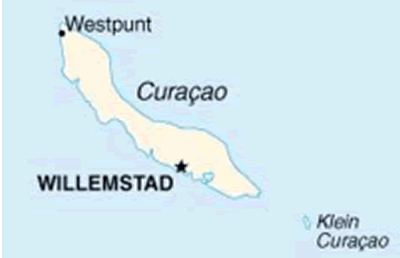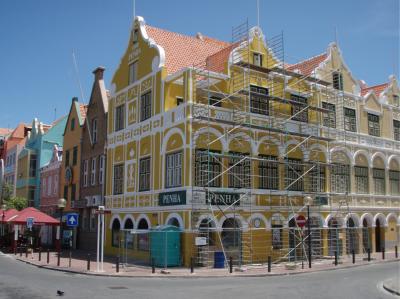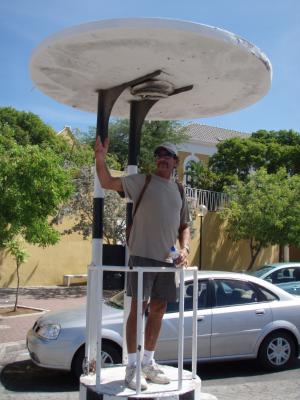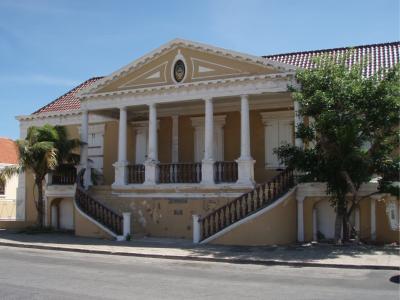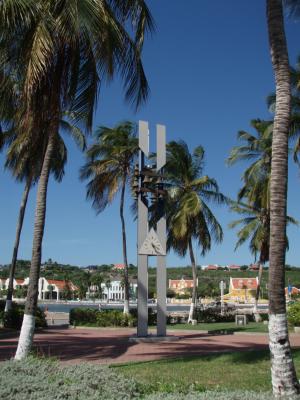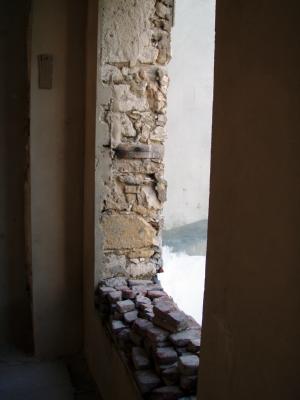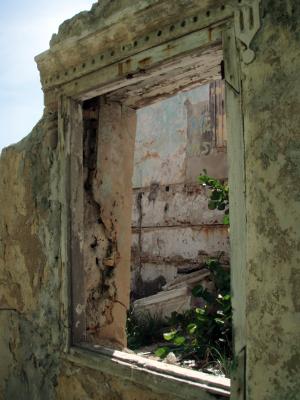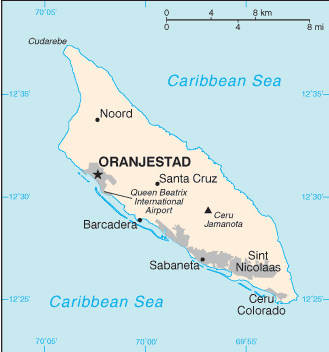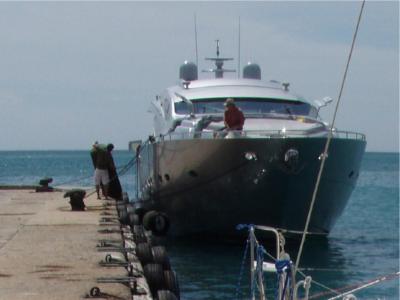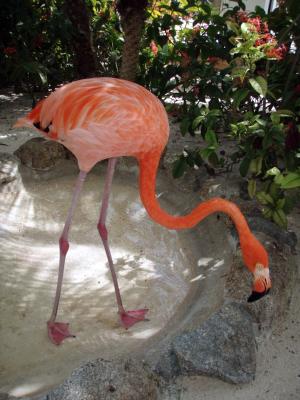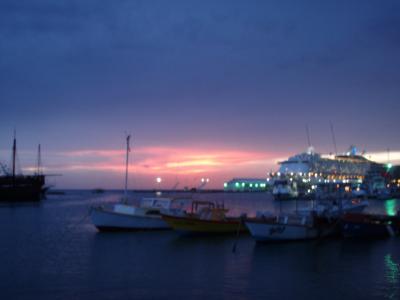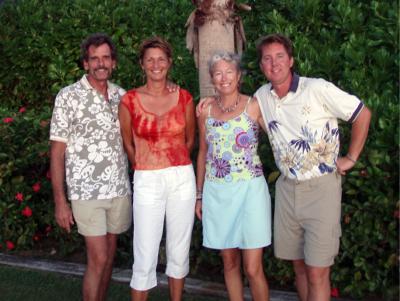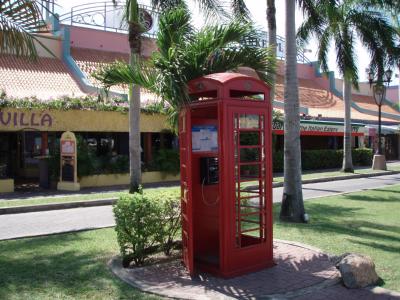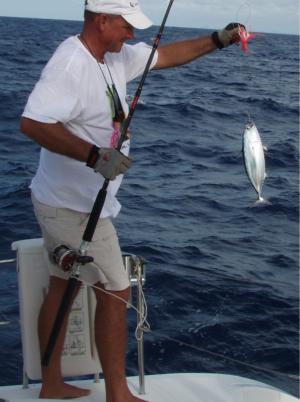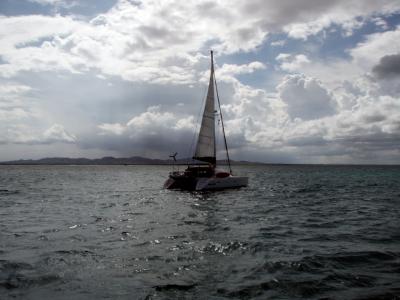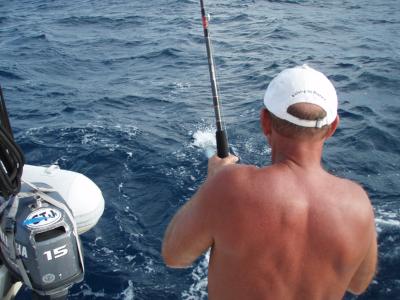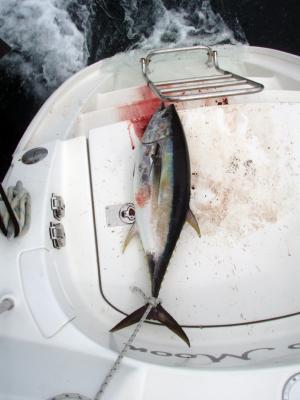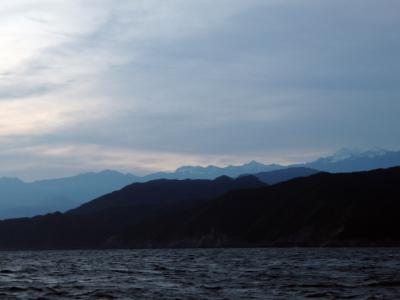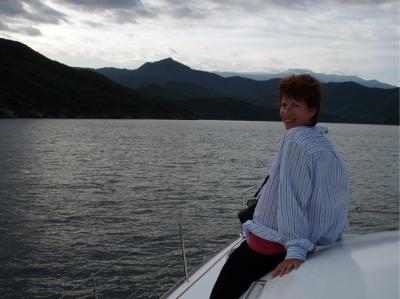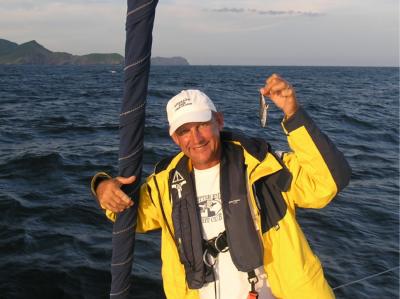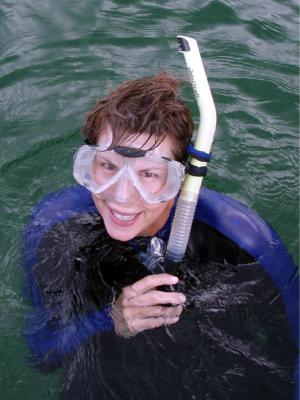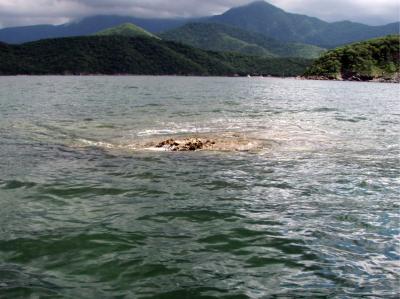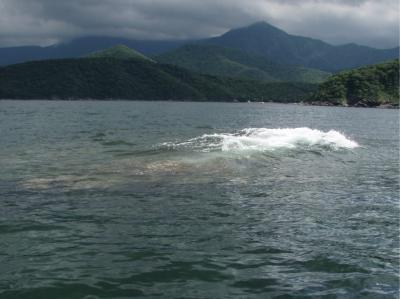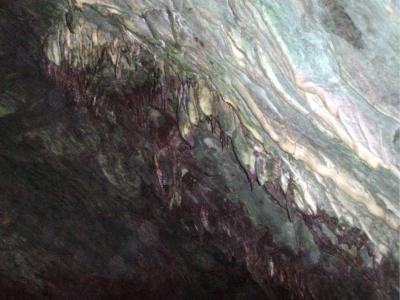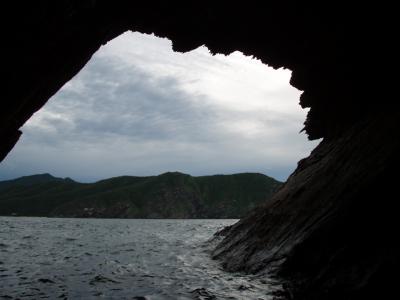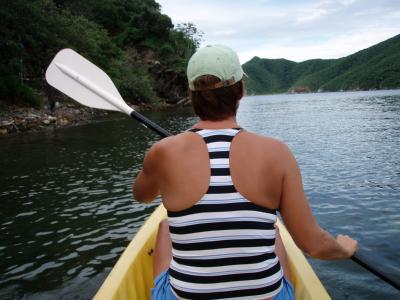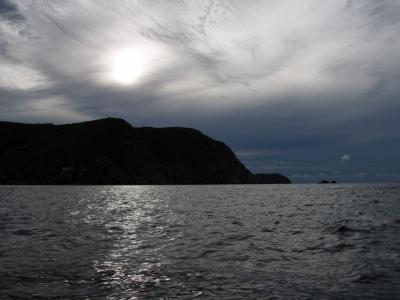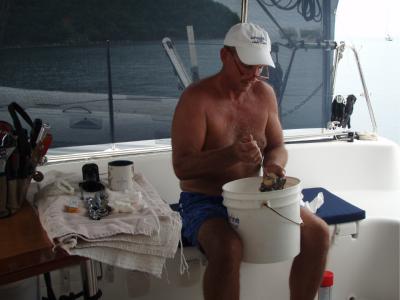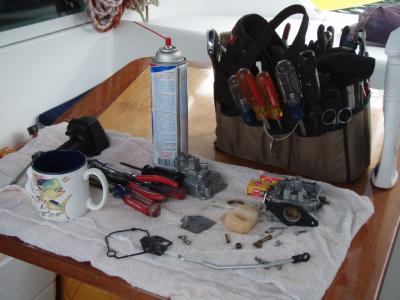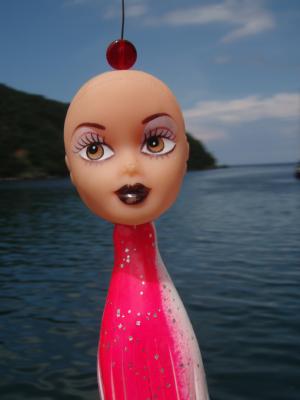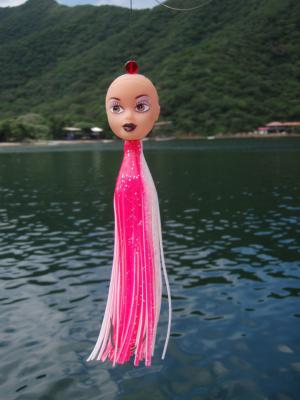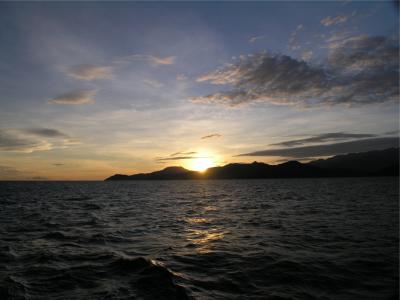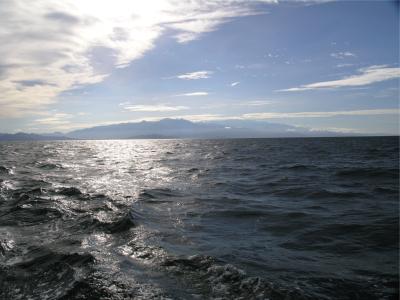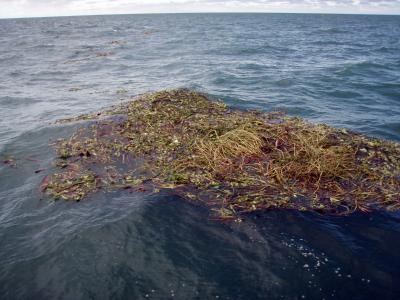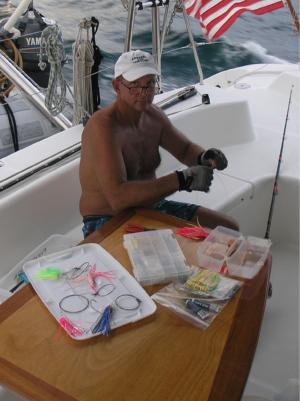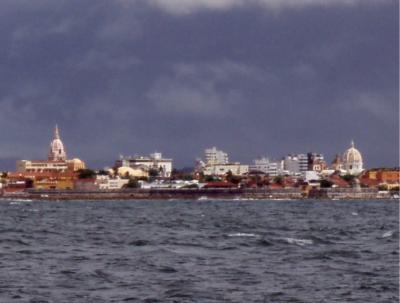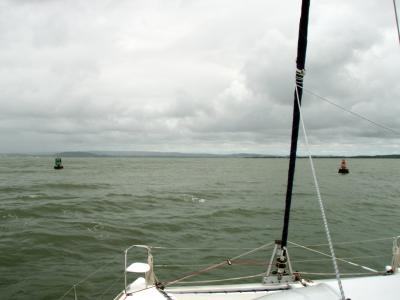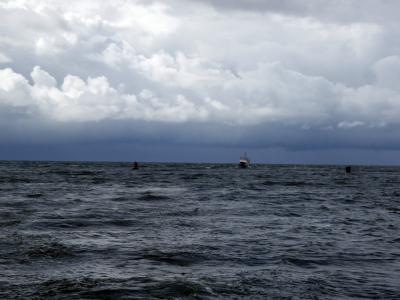
__________________________________________________________________________________________________
Bonaire to Cartagena, Colombia
September 27, 2007 - October 27, 2007
We spent the lazy days of summer in Bonaire while SCUBA diving to our hearts content. In the midst of our bliss we experienced a terrifying near miss with Hurricane Felix that left us shaken but feeling thankful. As the month of September came to a close, so did our ninety-day time limit with Immigrations in Bonaire. It was time to make a move and say a tearful goodbye to all our Bonaire friends, both new and old.
The only remaining question was “Where to next?”
We had vowed that we would leave Bonaire and return to St. John again, and volunteer as Maho Bay Hosts again for the 2007-2008 season, but instead we decided to head to the Western Caribbean.
The Western Caribbean is definitely"Act III" of the entire Caribbean Cruising experience and it marks a major step into a new cruising theater where the stakes are significantly raised: areas of very rough seas, more incidents of piracy, drug smuggling, and language barriers for those of us who are not fluent in Spanish.
Last year when we headed from Bonaire back to St. John, we watched good friends head west to Colombia and Panama, and they subsequently raved about it via e-mails.
So, this year we kept weighing the alternatives. Considering we had done the Virgin Islands twice already, it was time to head west and not risk missing the Western Caribbean. Moreover, cruising has a life span. A third helping of St. John might just be hubristic enough to anger the Gods. As they say: “pigs get fat and hogs go to slaughter.”
Also, whether due to financial constraints, health issues, or just plain wicked fate, we have been out here long enough to know from other peoples’ bitter experiences that Cruising is merely a lucky gift that can be snatched away in an instant . . . and the clock is always ticking, ticking, ticking.
In view of all that, we decided it was time to head west toward horizons brand new to us.
So, let’s set sail into the wild Western Caribbean!
But where will we go first? Well, we are departing Bonaire, the "B" of the "ABC" islands located 80 to 100 miles north of the Venezuela mainland, out in the Southern Caribbean. Really, the islands should be dubbed the "ACB" islands, because from west to east they are located in the order of Aruba, Curacao, and then Bonaire.
So, we'll head first to Curacao, the "C" of the ABC's and then Aruba, the "A" of the ABC's. From Aruba, we'll make the big jump to Colombia, and make hops along the coast of Colombia until we reach the city of Cartagena.
The plan is to stop over for a few days of provisioning in Curacao. Then we'll head further west for a couple of weeks of "vacation" in Aruba before heading on toward Colombia.
Aruba will be deemed a “vacation” for us because we have reservations at the Renaissance Marina and we already knew from other cruisers’ reports that there is a Dunkin Doughnuts, Taco Bell, Haggen Daz, Subway sandwich shop, Pizza place, and Multiplex Cinema right at the marina complex. We have not seen these things at any port since we left Ft. Lauderdale almost two years ago.
Also, there are huge supermarkets in Aruba that are by far the best-stocked in the entire Caribbean.
Add attributes like potable dock water, shore power, swimming pool, fitness center, air conditioning and real cable television and that spells v-a-c-a-t-i-o-n!
While enjoying all these wonderful amenities, we will wait for a weather window to make the ominous passage from Aruba to Cartagena, Colombia.
Let’s get going!
BONAIRE TO CURACAO
Leaving Bonaire was not easy. Many tearful hugs and goodbyes both in person and via VHF radio finally gave way to a raise of sails and a departure from the harbor at Kralendijk. We had new "buddy boaters" also destined for Aruba. Grant and Candace Grove on Manta 42 catamaran Reality were heading West too, so we set sail mid-morning for an easy run to the small Island of Klein Curacao, just 30 or so miles west of Bonaire.
Here is a chart of Curacao showing Klein Curacao to the southeast:
|
|
We had a great sail. Sometimes you get lucky. The wind speeds were 18 to 22 knots, allowing for full sail and full sail power. Any stronger winds would have required reefing the sails and reducing power.
The seas were just aft of the port beam. No slamming, no drama: a smooth, fast ride in moderate seas. Days like that whisper “circumnavigation” and if those conditions could be guaranteed day after day, we’d sign on to sail around the world.
But this perfect sail was over before we knew it. In no time we were tied to a mooring on the lee side of Klein Curacao. There is not much of an anchorage at this tiny island so moorings are used instead. Large boats on day trips come out from the big island of Curacao, hauling beachcombers and scuba divers.
Cruisers get away with using the moorings too because the day trip ferries don’t run everyday, nor at the same time. So, there are usually a few open moorings.
We were soon secure on the mooring, but we were far from settled. The large seas were wrapping around the island and we experienced beam-to swells that were really rocking the boat. In fact, the motion of the boat while sailing to Klein Curacao was extremely more comfortable than being moored in shelter behind it. Go figure. It was going to be tough to get a good night’s sleep.
As soon as we got the sails stowed, we went ashore to see what Klein Curacao is all about.
Grant and Candace (and their boat-dog Shadow), went ashore too and walked the beautiful beaches. Melissa and I dropped the dinghy down and headed in. While Melissa, Candace and Grant enjoyed the beaches on the western shore, I went on a walkabout across the half-mile width of the small island to see the lighthouse, a shipwreck, and a wrecked yacht that also met its fate on the eastern, windward shores of the island.
Here’s a look:
|
|
|
|
|
After a good look at the lighthouse, I walked quite a way to the eastern, rugged shores where a small ship and a large sailboat were decomposing in the heavy surf and trade winds.
|
|
|
|
|
|
|
|
Back at the beach the sun is getting low in the sky and I walk past some of the larger pavilions that host the throngs of beachgoers who get ferried out for day trips.
|
Soon I was back in the company of Melissa and Candace and Grant and we enjoyed swimming in the shallows as the sun set.
|
It was a great afternoon and we soon enjoyed dinner aboard the catamaran Reality. Candace cooked fabulous chicken enchiladas and we had a nice evening, even though it felt like we were underway while jerking side-to-side in the rough mooring field.
By the next morning, I was beat! The boat kept yanking me side to side all night in the swells and I would wake up every thirty minutes, having been literally shaken awake by the awkward, quick motion of the boat in the untenable seas.
We were soon greeted with a fly-by of the Curacao Coast Guard. This is Drug Smuggling Territory and there is a close watch kept on vessels of all kinds.
Earlier in the season, we heard that our friends on the Amel Super Maramu yacht "BeBe" were stopped and their yacht was searched completely and thoroughly by the Coast Guard here, all because another yacht came into the same anchorage after dark and did not spend the night. It must have looked suspicious to the Coast Guard.
So, we knew the patrols would be aggressive.
|
|
We marveled at the low flying helicopter and the first of the day's charter boats coming in. But, despite the beautiful beaches and water, it did not take long for us to decide that we did not want another night of Hell in the wild sea conditions and by 10:00 a.m we were headed to the main island of Curacao and a calmer anchorage.
The big island of Curacao has a large, perfectly protected "network" of several, large inland bays known as Spanish Waters. It is a favorite "Hurricane Hole" and great anchorage. The entrance is so narrow and winding that you would never in a million years think the small inlet would lead to such a huge bay.
There are actually several zones designated for anchoring in Spanish Waters and we settled on an open spot next to catamarans Maker’s Match and Reality.
Before we give you a look around Curacao, let's review a little history about this island, courtesy of information derived from wikipedia.com:
Curacao is the largest and most populous of the ABC islands. Just like Bonaire, it is part of the Netherlands Antilles and is part of the Kingdom of the Netherlands. It's capital city is Willemstad.
The island has an area of 171 square miles and has about 140,000 residents.
Arawak Amerindians were the first inhabitants. The Spanish were the first Europeans to arrive on Curacao in 1499. The Spaniards took control and exported the indigenous people, shipping them to other Spanish colonies in need of labor.
The island was eventually occupied by the Dutch, however, beginning in 1634.
The Dutch West India Company founded the capital of Willemstad on the banks of an inlet called the 'Schottegat'.
Lacking gold or any other natural resource of value in that day, Curacao was not important until such time that it was developed as a port of trade. By 1662, Curacao, and its large natural harbors became an ideal spot for trade. Commerce, shipping, and, of course, piracy flourished.
Most notorious is the fact that Curacao then came to play a pivotal role in the Atlantic slave trade, a trade deemed "one of the most intricate international trade networks in history."
The Dutch West India Company made Curacao a center for slave trade. Dutch merchants imported slaves from Africa under a trading agreement with Spain. Large numbers of slaves were sold and shipped to various destinations in South America and the Caribbean.
The slave trade made the island affluent and financed the construction of impressive colonial structures that infuse various Dutch and Spanish colonial styles.
Willemstad is on UNESCO's world heritage list and many structures have been and are being restored.
During the 18th and 19th centuries, the island changed hands among the British, the French, and the Dutch several times. Stable Dutch rule returned in 1815, at the end of the Napoleonic wars.
The Dutch abolished slavery in 1863. The end of slavery marked a severe decline in the economy of Curacao, just as it did in almost each and every other island economy in the Caribbean. Most trade and agriculture businesses were dependant on slave labor to turn a profit. And Curacao, like most all the other Caribbean islands, was then facing a future of poverty and poor prospects for economic development.
Then the unexpected happened on Curacao! In 1914 oil was discovered and the economy of the island stuck it rich. Royal Dutch Shell and the Dutch Government built an oil refinery and the installation was placed on the former site of the slave-trade market at Asiento. Oil replaced slave trading and established an abundant source of employment for the local population.
This lucky windfall fueled a wave of immigration from surrounding nations. Curacao is an ideal site for the refinery, away from the social and civil unrest of the South American mainland, but near enough to the oil fields. It also has excellent natural harbors big enough to accommodate large oil tankers. The oil company brought a degree of affluence to the island. Large housing developments were provided and Willemstad developed an extensive infrastructure.
However, a strong economy did not bring an end to all conflict. Discrepancies started to appear amongst the social groups of Curacao. Large scale rioting and a protest on May 30, 1969, marked a turning point for Curacao and its Afro-Caribbean population attained more political power.
In the mid 1980's Royal Shell sold the refinery to a local Curacao government consortium that currently leases the refinery to, of all things, the Venezuelan state oil company PDVSA.
Currently, the people of Curacao are voting in such a way that suggests that the government will eventually seek full independence from the Netherlands Antilles. Aruba has already made such a move and is totally self-governed.
As in the Netherlands, prostitution is legal on the island of Curacao and also on its "little sister" island Bonaire. In Curacao, a large open-air brothel called "Le Mirage" or "Campo Allege" operates near the airport and has since the 1940s. The Netherlands' approach to prostitution is to monitor, contain and regulate it, and see that "the workers in these establishments are given a safe environment and access to medical practitioners."
The languages widely spoken are Papiamentu, Dutch, Spanish, and English. Many people can speak all four of these languages. Spanish and English both have a long historical presence on the island alongside Dutch and Papiamentu.
Baseball is a big deal on Curacao, just like it is in Venezuela. For the past seven years the Little League baseball team from Willemstad, Curacao has made it all the way to the Little League World Series in Williamsport, Pennsylvania. The team features players from ages 11 and 12 who represent the Caribbean region. In 2004 the team from Willemstad, Curacao won the title game against the United States champion from Thousand Oaks, California.
So, now that we know a little bit about Curacao, let’s check it out!
|
|
|
|
|
|
|
After getting anchored in Spanish Waters traveling to Customs and Immigrations is pretty doggone inconvenient in Curacao: dinghy into a fisherman's marina; walk to the bus stop; ride a bus for twenty minutes to Willemstad, walk a quarter of a mile to the Customs building, then walk across the swing bridge and another mile or so to the Immigrations building on the other side of the harbor.
Then, just to make things even more arduous, we waited an hour in the mid-day heat because the Immigrations Officer was late. After it was all over, we had to complete the entire round trip back to the boat.
It’s at least a half day affair to check-in at Curacao and it wins the prize as the Number One most ridiculously inconvenient place in the Caribbean due to the fact that Customs and Immigrations are so far from the anchorage and also pretty far apart from each other. St. Kitts is a close second as far as being the worst access to Customs and Immigrations when arriving on a private yacht. No other destinations we visited are even close to being as inconvenient as Curacao and St. Kitts.
Of course, I am talking about the hassle of physically getting to Customs and Immigrations. As far as the officials themselves being nasty, I cannot imagine any place in the world ever topping the Immigrations Officer at Road Town, Tortola in the British Virgin Islands. She still easily holds the record as the nastiest, most mean-spirited and hateful Customs and Immigrations official that we encountered to date.
Luckily, though, the streets of Curacao's capital city of Willemstad were interesting enough to ease the frustration of the long walks to Customs and Immigrations.
Just so happens, it was National History month and the Customs office was paying tribute to the heritage of Curacao with a display of antiques demonstrating life from the days of old.
We also found out t he Customs Officers are quite good at softball and play in a local league of competing government and law enforcement agencies. I had fun chatting with the Customs Officer and he had no qualms about telling me that the Customs' softball team takes great pride in whipping the police department's team.
|
|
|
After Customs, it was off to Immigrations. We had to walk down the seawall of the Santa Anna Bay (the main harbor of Willemstad), to the floating swing bridge, cross it, and then walk a half-mile or so back inland to Immigrations.
The bridge is the world’s oldest swinging bridge and it is the world’s longest moving pontoon bridge. Originally built in 1888 and named the Queen Emma Bridge after Queen Regent Emma who married King William III in 1879, the bridge was refurbished in 2006 and is used for foot traffic only.
It is quite unusual. It floats on a series of what looks like small boats. One end of the bridge is fixed to a hinge. The other end rests on an “end boat” that has engines to power the bridge and make it swing open or shut. No steering wheel needed!
|
|
|
|
|
|
|
|
|
|
|
|
|
|
|
We are getting closer to Immigrations. Now we have to walk into a secure wharf area and along the waterfront up a row of warehouses to get under the big high rise bridge. Some of the warehouses have been painted with artwork.
|
|
|
|
|
|
Soon more cruisers started piling up outside Immigrations and before long about a dozen of us were standing around waiting. Almost an hour later a lady showed up and started checking people in. All went well, but there was one more stop to make. As soon as the Immigrations Officer handed me back my papers, she curtly instructed me that I must immediately proceed to the building next door and obtain an anchoring permit.
In Curacao, you are required to obtain an anchoring permit from the Harbor Master’s Office. The permit is very specific and limits you to a numbered zone in the big bay at Spanish Waters and also regulates stops at any other anchorages on your way out of Curacao, etc.
Sounds easy enough, but the Harbor Master’s Office is not open on weekends and it is Saturday! I already knew this. So, I looked the Immigrations Officer in the eye (already having all my papers in hand and having concluded all business with her) and said in a very even tone: “Why would you have me walk even further in the hot sun to wait at the Harbor Master’s Office when you know it is closed today!”
She would not respond verbally. But her look was: “What? Are you stupid? It’s because I hate you!” Some Officers are mean-spirited and love to cause cruisers hardship. Those types hate it when you outsmart them and avoid part of their intended "punishments."
In the end, I opted not to spend an additional whole day to make a completely new trek to get an anchoring permit. We were staying less than a week and we were legally in the country (both people and the boat) and were anchored in a proper zone. Thus, there was less than a miniscule chance that we would be bothered about the lack of an anchoring permit.
All went well and we never had any trouble sans anchoring permit. But, all said, again Curacao easily wins the prize as the most ridiculously inconvenient place to check into when arriving on a small sailboat.
And while it might feel like it's a personal affront to cruisers, it is much more a situation wherein cruisers do not matter all that much on an oil refinery island. Their economy does not need to make accommodations to cruisers. Cruisers are welcome enough, but the Curacao government agencies are obviously not going to go out of their way to improve things for us.
Hey, and why not. It is their island and they don't need a dime from cruisers. So after checking in, we took it all in stride and started walking back toward the floating bridge, through downtown on a sightseeing expedition, and enjoyed a late lunch before returning to the boat.
|
|
|
|
|
|
|
|
|
|
|
We already knew that Curacao was not all that convenient for cruisers, but we stopped in Curacao mainly to provision. While there is not much of a selection of groceries in Bonaire, Curacao offered large grocery stores that stock brand names and quality products. Oil money does that sort of thing to the standard of living.
Melissa will tell you that she really liked Curacao and was glad we stopped there, even though we could have gotten everything we needed in Aruba.
Curacao is often touted as a better provisioning destination than Aruba, but it just ain’t so. I found better grocery stores in Aruba (first class, huge stores that had things we had not seen since Ft. Lauderdale). It is true, however, that fuel is a good bit cheaper in Curacao and that was a good reason to stop. In the end, stopping at Curacao is a close call for me.
There was one more thing that perhaps tainted my opinion of Curacao. I got a terrible stomach virus while there. It started as a knot in my stomach on the boat one morning and then the knot tightened and tightened into severe nausea. By midday it was ninety degrees, no breeze, and I was soaked with sweat even in the shade. I spent the afternoon moaning in between several episodes of throwing up and eventually dry-heaving into a bucket. It was the essence of miserable. I finally took some phenergren and dozed off.
That makes three bouts of stomach flu in as many years cruising: St. Martin; St. John and now Curacao. In each of those places I had terrible stomach virus attacks (well, actually I think I was poisoned by a filthy French restaurant in St. Martin). Anyway, I am hoping that the old saying “things come in threes” is true.
Before going cruising I had not vomited in probably twenty-five years and always prided myself as having the intestinal fortitude of a Billy Goat.
Regardless, the experience of being really ill on the boat does in fact affect how I feel about a destination, fair or not. When I think of Curacao, I think of being terribly ill, having to go through an absolutely ludicrous routine to check in with Customs and Immigrations, and then finding out later in Aruba that there was no advantage whatsoever to provisioning in Curacao.
I did save about two hundred bucks on fuel. And the island was pretty and some of the sightseeing was fun. But with just about equal amounts of really good and really bad, Curacao was pretty much a zero for me.
Hey, don't get me wrong. We kept our spirits up and there was no use bitching about it. In a few days I was on the mend.
And during our stay in Curacao Chuck and Terri from Makers Match, and Grant and Candace from Reality rented a car with us and joined us on several “walkabouts." Good friends make any destination a pleasure.
Here are a few more looks at Curacao:
|
|
|
|
|
|
|
|
In between sightseeing, we also sought out items we needed for entering the Western Caribbean, such as paper nautical charts. We had not planned to head west this year and did not have all the charts we needed. We had guide books and the electronic charts for the GPS, but we needed plain old paper "back-up" charts for Colombia, Panama, Honduras and Belize, etc. We found a copy store in Curacao that sold charts very cheap.
Turned out in the end that they sold copies of charts. And that is not all: their inventory apparently came from copying charts of prior cruisers passing through. The charts they sold had hand-written annotations from the original owners who probably came in and asked to have copies made for their friends, etc. Apparently, when a new and different chart is dropped off at the copy shop, they make themselves a copy too and then add it to their inventory for sale.
We also found big Home Depot-type hardware stores and stocked up on things like paint brushes, epoxies, duct tape and blue tape and such. We shopped electronics and hit the Napa store as well.
We alternated "work days" with "play days."
One weekend we went to a large indoor Caribbean Arts and Crafts Fair that was fun. Also, we enjoyed a neighborhood open house in an old city district that is undergoing a total restoration.
Here is a look:
|
|
|
|
|
|
|
|
|
|
After riding buses and walking around, we returned to the boats in the bay at Spanish Waters and watched the sunset.
|
After a week in Spanish Waters, it was time to move on. Next stop: Aruba, only 65 miles away. The trip can be shortened somewhat by heading fourteen miles to the very northwestern end of Curacao and spending the night there at the small bay of Santa Cruz. By departing at first light, Aruba, which is about 50 miles away, can easily reached by early afternoon.
Let’s get going!
We planned to depart the anchorage at Spanish Waters midmorning. We needed to take advantage of that cheap fuel, though. It will take full fuel tanks and all our extra fuel drums and jugs too to make the five day coastal-hop passage from Aruba to Cartagena, Colombia, so we were planning to buy all our fuel in Curacao and save a couple of hundred bucks.
The private, powerboat-heavy Curacao Yacht Club is located in Spanish Waters, only a stone’s throw from where we were anchored, has the only fuel dock in Spanish Waters. It has strange hours and is only open a few days of the week.
As we got ready to pull anchor, wouldn’t you know it?! A big powerboat snuck up to the fuel dock. And it sat there and sat there and sat there. I could see with binoculars that no fuel hose or water lines were running to the boat. After an hour passed, with no other boats in line, it looked like the crew was probably just hanging around. So, we pulled anchor, motored over, and began the “close-range drive-by and hold-up routine” stalking back and forth and obviously waiting for our turn at the fuel dock.
No luck. A lone deckhand was aboard and he ignored us. After all, it is a private yacht club that just so happens to sell fuel to the public, if and when it is convenient for them.
After a futile ten minutes of the drive-by routine, I motored really close in and called out to the lone crewman, asking how long they were going to be tied up the fuel dock.
The answer: “We have engine trouble and one of our engines is dead. This is the only place we could dock in the wind; can’t back into the slip on one engine. The Captain left and didn't say where he was going. I don’t know what will happen.”
It pays to ask questions.
Well, okie dokie! It was clear that nobody was going to set adrift a big broken down power yacht owned by a club member in order to sell one hundred forty gallons of fuel to a foreign sailboat. The dock was only big enough for one boat, so, it was on to Plan B and daylight is wasting.
Melissa perused the Cruising Guide and found the Opus Marina, located in Piscadera Bay. She called on the satellite phone. Yes, they have fuel. Yes they have a fuel dock. Yes they will be expecting us. No problem!
So, we split and headed for Piscadera Bay, only five miles up the coast from Spanish Waters (and on the way to Santa Cruz Bay anyway). An hour later we are headed into Piscadera Bay. Its entrance is very narrow, just like Spanish Waters, but after a short run it opens into a really big bay. We worked our way toward where we thought the Opus marina is located.
We found some docks and a boat yard, but no marina per se and no fuel dock. The place we have found is purely industrial-looking with a few short, shaky finger piers running out from the shore and that’s it. Nobody was around. There was no place to dock. The piers were full. It looked deserted.
Melissa got back on the phone and talked to the same guy. He emerged, cell phone in hand, from the yard full of boats and pointed to a big white container up on a bluff. It was then that I realize that the container is a skid-mounted, self-contained fuel station that can be winched up on a flatbed truck and moved: basically a portable gas station.
Okay, but we still have no place to dock. The tiny dock near the fuel station is full of boats already, except for a few feet at the shore. So, I’m wondering: what’s next?
The guy un-reeled the fuel hose all the way and it barely reached the first ten feet of the dock. Then he told us to back in, perpendicular to the dock and all the way at the shore so that the hose would reach! We gave it a try.
As we get closer and closer to the shore, Melissa pointed at the shallows and asked: “How deep is it right there?”
His non-answer and counter question: “How much do you draw?”
Melissa: “Four feet.”
Answer: “You’ll be fine.”
Going ever so slowly, the boat stopped dead about 30 feet from the pier. No crunch, no shudder, just an imperceptible transition from moving to stationary. Yep, we are on the bottom and it’s mud.
Great!
Ok. These are the times when cruising is an ordeal no matter what your attitude. Only a lobotomy coupled with psychedelic drugs would make this an adventure.
So there we were: stifling in the heat and aground off a dusty boat yard that does not, by any stretch of the imagination, have a fuel dock -- but there we were, lured right into the mud just the same. And the yard manager is smiling.
This is when you have to “Man Up.”
I smiled back and said “no problem."
The bay is calm and big. So, we motored out of the mud with ease and out into the middle of the bay. I dropped the dinghy down (which was already extensively lashed down for offshore work). Melissa took the helm and held up under power in the safe water. Using the dinghy, I took one 15 gallon drum in at time (six trips).
The first 15 gallon drum proved way too heavy to manhandle from the dinghy to the deck of Indigo Moon. I did it, but it was way too risky on all counts and I was lucky not to have injured myself.
The next five drums were hoisted with the dinghy engine crane (lot’s more time and trouble).
Then, it was another set of trips with four 5 gallon jugs. Back and forth to fuel the boat's main tanks and then to fill the jugs to be stored on deck: two trips, plus the time to pour four jugs into Indigo Moon’s main fuel tanks.
Oh, and lest we forget, I was still really weak from my stomach flu the day before.
I merely relate this part of the story to keep providing an even-handed report on our cruising life and include the tough parts too. Cruising can be very hard sometimes. There is no use complaining about any of it, though, and I think that is the real transition to a cruising attitude. You get to a point where you do what is necessary and not waste ANY energy complaining or being upset.
In the USA we have been conditioned to be a society of “complainers.” It seems like there is always someone within earshot demanding to “see the Manager” about this or that grievance, or someone nearby making a statement about how things should be.
Cruising has broken us of that spoiled USA habit. For one thing, it just does not work out here. Sure we encounter ordeals of the first degree that would merit "strong letters to the management" back home, but out here we have learned to simply keep our mouths shut, be friendly and deal with the trouble as quickly as possible and move on to happy times again.
As fun as some of the great cruising slogans may be, better, more-honest credos for cruisers facing tough episodes might be: “whatever it takes” or perhaps “shut up and dance.” Or, always a favorite of mine: "I want my Mommy!"
But Mommy ain't coming. We took care of business and then motored out of Piscadera Bay, simply happy to finally have the fuel. Once we got into open water and into the cool breeze underway, we relaxed and laughed about how that episode would have been a REALLY big deal if it had happened in our first month of cruising.
It was late afternoon by the time we reached Santa Cruz Bay on the western end of Curacao. Our friends Grant and Candace Grove on catamaran Reality had already been there for hours. Also, there was one other cat in the anchorage.
We anchored and settled in for the night while watching a big thunderstorm just to our southwest! I took about thirty pictures of the lightning and got a couple of good shots showing lightning bolts striking the sea surface.
|
|
Curacao to Aruba
Here is a chart of Aruba:
|
The next morning, we all set sail early, bound for Aruba. Before you make landfall with us, let's review a little bit about Aruba's history.
The following is derived from information courtesy of wikipedia.com:
Just like Curacao, Aruba's first inhabitants were Amerindians from the Arawak tribe, who migrated there from Venezuela to escape attacks by the Carib Indians.
And, just like Curacao, Aruba was first "discovered" by the Spanish in 1499. Aruba was colonized by Spain for over a century and ultimately fell under Dutch control in 1636. Thereafter, Britain occupied Aruba from the years 1799 to 1802, and from 1805 to 1816, but ultimately remained under Dutch control.
And also just like Curacao, Aruba hosted an oil refinery and its economy grew.
In 1933 Aruba drafted its first petition for Aruba's separate status and autonomy to the Queen of the Netherlands.
During World War II, both Aruba and Curacao were then world-class exporting oil refineries and were the main suppliers of refined oil products to the Allied Forces.
On February 16, 1942, Aruba's oil refinery was attacked by a German submarine (U-156) under the command of Werner Hartenstein. Miraculously, the mission failed and the U-156 was later destroyed by a US plane while the submarine was surfaced with it's crew sunbathing; only one submariner survived the attack.
Aruba's economy has been dominated by five main industries: gold mining, phosphate mining (The Aruba Phosphaat Maatschappij), aloe export, petroleum (The Lago Oil & Transport Company and the Arend Petroleum Maatschappij Shell Co.), and now tourism.
Unlike its sister "ABC" islands, Aruba fought for and gained complete autonomy and equal status within the Kingdom of the Netherlands. As of January 1, 1986, the Kingdom of the Netherlands has consisted of three completely autonomous, constitutionally equal countries: the Netherlands, the Netherlands Antilles (that include Curacao and Bonaire), and Aruba. In practice, however, the Netherlands has considerably more power than either the Netherlands Antilles or Aruba.
Aruba is renowned for its white, sandy beaches on the western and southern coasts of the island, relatively sheltered from fierce ocean currents. Neither Curacao nor Bonaire have extensive beaches and Aruba's spectacular, tranquil beaches make it a vastly superior tourist destination. Most tourist hotels are located on the leeward side of the island, providing better weather and enjoyment of beaches and ocean.
Aruba enjoys one of the highest standards of living in the Caribbean region and the lowest crime rate; low poverty and unemployment rates are also positives for Aruba. About half of the Aruban gross national product is earned through tourism or related activities and the influence of the oil processing business is now minimal.
The G.D.P. per capita for Aruba is calculated to be around $23,800, one of the highest in the Americas.
Aruba has the second largest seawater desalinization plant in the world (Saudi Arabia has the largest.)
Because of almost no rainfall, Aruba was saved from plantation development and the economics and social tensions of the slave trade that seriously affected Curacao and many other islands in the Caribbean.
Aruba's population is estimated to be 80% mestizo and 20% other ethnicities. Most of the population is descended from Arawak Indians, and to a lesser extent Spanish, Italian and Dutch and a few French, British and African ancestors.
The capital of Aruba is Oranjestad.
Language can be seen as an important part of island culture in Aruba. The cultural mixture has given rise to a linguistic mixture known as Papiamento, the predominant language on Aruba. The two official languages are the Dutch language and Papiamento. Papiamento is a language that has been evolving through the centuries and absorbed many words from other languages like Dutch, English, diverse African dialects, and most importantly, from Portuguese and Spanish. In light of the fact that tourism is a main industry, English is widely spoken.
Aruba's tourist industry touts it to be "One Happy Island" and it is one of the most commercially developed tourist destinations in the entire Caribbean region.
And so, Aruba really is a vacation from Caribbean island cruising: no history of slavery and thus no harsh racism against white tourists; excellent beaches; excellent restaurants, first-rate modern grocery stores and great shopping; and, very happy and friendly people who work hard and depend on tourism for the success of their economy and their continued high standard of living.
So, let's get checked in and see what all the buzz is about!
We had an easy run from Curacao to Aruba. Catamaran Reality led the way and we followed about a mile behind, dragging fishing baits and hoping Reality would "raise fish", but no luck.
By noon we were headed into the harbor in Aruba and to the docks at Customs and Immigrations. Aruba has a notoriously bad reputation for only one thing as far as cruiser are concerned: its check-in procedures require cruisers to land their boats at commercial cruise ship docks!
You can’t anchor or go to a marina first and then go to Customs and Immigrations. Instead, you are REQUIRED to dock at their ship docks where cruise ships are berthed: concrete piers; black tires; rusty steel bolts securing huge wood beams, and huge bollards (cleats) spread way out and designed for ship-sized docking. It’s no place for a small pleasure boat.
But, remember, there is no use wasting our time by complaining . . . .
So, "whatever it takes" and keep smiling.
|
|
It was all over soon enough. The Customs officials actually come out to you at the dock, and then they give you a ride to Immigrations (a two minute walk away and located within the ship dock complex). The Officers were ultra-friendly and "at our service." That was a nice change.
It was not so easy for a James Bond-type super fast and sleek power yacht, though. They docked in front of us to check in and had just been stopped underway by the Coast Guard and were completely searched. The Coast Guard officers even swabbed the crews' cell phones for drug residue analysis! So, their arrival in Aruba was somewhat more protracted than ours!
|
In no time we were done with checking in and were untied and headed toward Renaissance Marina, just a mile or so away. They have two sets of dock spaces. One is against the shore directly facing the opening to the small, square bay and it is subject to ocean swells.
The other option is a seawall, tucked around the corner behind the rip rap to starboard as you enter the little bay. It is much more protected, but there are no finger piers; just “Med Moor” style docking where you back up to the wharf and tie off on a mooring, or in our case, where there is not a mooring, you have to drop anchor and back in, just like we did in Marina Margarita in Venezuela. YIKES!
We had a choice of “Med Moor” with our anchor (right next to Reality who got the last mooring spot), or tie up at the other set of piers and risk the swells.
We opted for Med Moor and protection out of the swells and it worked out for the best. Later in the week our friends Chuck and Terri Hill on catamaran Maker’s Match came in for a few days and the swells were so bad at the other set of docks that they popped a dock line!
Once we were secure in the marina, it was time to let the good times roll!
How about a dozen Dunkin Donuts for breakfast -- everyday! Then, off to the movies at the Cineplex only a five minute walk away where we saw The Bourne Ultimatum.
Lunch? Run for the Border at Taco Bell right in the marina complex! How about dinner and two huge racks of first-class for-real Baby Back Ribs at Iguana Joe’s? (for less than twenty bucks!) Or, how about a really amazing, best you have ever tasted steak at El Gaucho? Or maybe genuine first-rate Cuban food! Before turning in for the night, let's get ice cream at the Haggen Daz right there at the marina!
Gambling in your blood? There is a Casino right in the marina. We never went inside, but if it is your thing you can literally leave your boat and place a bet within three minutes!
And there are REAL cable tv hookups on the shore power pedestals on the dock by the Casino where we were. Not "Venezuela" cable with only three fuzzy channels, but real "channel surf mania" cable. We enjoyed lounging in our bunk with the AC on 72 degrees, with a blanket on the bed and watching all sorts of TV we had not seen for a long, long time, like the National Geographic Channel, Discovery Channel, all the News channels and Melissa's Hollywood gossip channels. We also got to watch a fabulous LSU football game wherein the Tigers cinched their first Number One ranking.
Hey, cruising in remote areas is way cool, but there is a LOT to love about "civilization" too! And we were lapping it all up in Aruba and loving being in such a developed, amenity-laden location.
Got enough of the AC, napping and cable tv? Then how about a day at the beach? The Renaissance Hotel has its own private island, compete with tame pink flamingoes, Bar and Grill, and two different beaches: adult only and the family beach. The hotel runs shuttle boats out to the island. The boats also stop at the marina and the main hotel all the way inside the bay. There is a canal that runs under the waterfront roadway and into a tunnel that connects with a tiny little bay and dock inside the hotel lobby. It’s like a Disney World set. At the main Hotel, there is an upscale pool up on a terrace that overlooks the bay and the Marina. As marina guests, we had use of the entire facilities.
What about groceries? There is BY FAR the best selection of foods and products in the entire Caribbean to be found in Aruba.
Aruba’s slogan is “One Happy Island” and it has succeeded in developing the island into a first-class tourist destination that will not disappoint tropical sand and surf enthusiasts. In my opinion, it handily edges St. Martin out of the picture and is the number one resort island in the Caribbean. Aruba is much cleaner and has a better beach. Plus, there is a much wider range of first-class restaurants in Aruba.
Yes, in our view, Aruba easily takes the number one spot by far as the coolest “hotel guest beach bum” destination in the entire Caribbean. On the western, lee side of the north end of the island there is a spectacular beach that is lined with a few high-rise hotels. Restaurants, shops, and ancillary businesses line the main streets that support the huge hotels.
The beach scene includes: SCUBA diving, water sports equipment rental kiosks, beach umbrellas, rental gazebos for lounging under the shade of silk screens flowing in the breeze, massage tables in the shade of coconut palms, swimming pools, and various seaside Bars and Grills.
As beautiful as any scene in your tropical mind, the turquoise waters and white sand beaches equal the Florida Panhandle.
But, interestingly, despite the big hotel developments, there is no sensation of overcrowding like Miami Beach or Destin, Florida. It all feels wide open and perfect.
We had a blast in Aruba and it is on a very short list of places we would visit again in the Caribbean, even if it means going by airplane and getting a room on the beach.
We were not there long when Todd and Lynn Fulks on Blue Marine came into the marina too. We attended a fun Birthday Party for Todd aboard Blue Marine: his 43rd! There were many dinners out, and we had the best cruising vacation you can imagine.
Here’s the Aruba photo journal:
|
|
|
|
|
|
|
|
|
| You have to take a second look, because at first the flamingoes don't seem real |
|
|
|
|
|
|
|
|
|
We really enjoyed the area around the Renaissance Marina and walked to dinner several times. But, to see the big beach and hotel district on the far north end of the island, we rented a car for a day. That allowed us to cover lots of ground and get a good look at what the main tourist area of Aruba is all about.
|
|
|
|
|
|
|
|
|
|
|
|
|
|
We had a great day of touring Aruba's north end. What a fabulous island. It has been perfectly developed and stands as the prime example of just how successful an accommodating Caribbean island can be as a tourist destination. Its people are friendly, and they bend over backwards to make guests happy. And, they are comparatively the richest people in the Caribbean as a result of their willingness to simply be genuinely friendly to tourists.
Yes, it was turning out to be a great vacation.
But, back at the marina, it was not all play and no work for me. Cruisers never get a vacation from boat maintenance, ever.
After accumulating five years and 4,000 hours on our Phasor brand electrical generator (only about 1/4 of its expected life), its rubber engine mounts were no longer supple. The engine mounts had become hard, worn, and the generator was vibrating the boat too much.
I talked to Alan Murasso at Southeastern Power, the Phasor Generator manufacturer in Ft. Lauderdale, and I ordered new mounts. Alan is a great guy and I first met him at the 2005 Annapolis Boat Show. I can't say enough good things about Alan, Southeastern Power, and Phasor. They are first class all the way!
We met fellow cruisers Brad and Gloria Smith, from yacht Kindred Spirit, in Bonaire. Brad had flown back to the USA and he was kind enough to bring my new generator mounts back with him to Curacao. We hooked up with Brad and Gloria again when we were in Curacao and they gave me the parts then.
That is the preferred method of getting parts in the Caribbean, by the way. When cruisers fly home, they always have a list in hand of all the items they need to bring back for all their friends in the anchorage. The items hauled in are usually boat parts and/or mail. It saves cruisers hundreds of dollars in expensive shipping and duty fees that often double the normal price of the parts. Brad was a "Prince of a Guy" to haul my new engine mounts in one of his suitcases.
The generator job was already slated for Aruba, where I knew we would have shore power and not need the generator to charge batteries and make water, etc. Phasor upgraded the latest version of engine mounts.
Luckily for me, the new, different mounts utilized the exact same bolt pattern and bolt/thread sizes so there was no re-engineering needed. Even though the new engine mounts were perfect in every way, it was still a tough job. Our Phasor generator is located in a locker in the bridgedeck and it is pretty much a “ship in a bottle.” It weighs over 400 pounds.
I had to rig a series of lines and blocks to use the spinnaker halyard and a cockpit winch to lift the generator, one end at a time, and get the old mounts out and install new ones. all while squeezing in between the engine and the locker opening like Houdini trying to wiggle in and out of the impossible. It was an “all day sucker” as they say in the mechanic business.
But then again, nothing went the slightest bit wrong. No pitfalls, no unexpected roadblocks, no parts that didn’t fit, no dropped and lost nuts and bolts, no special tools required and no unanticipated problems whatsoever. The job went precisely as I planned it.
Thus, it was a really hard job that was terrifically easy; all you mechanics out there know exactly what that means.
Once the new mounts were installed, the Phasor purred like a kitten again.
I wish I could elaborate more about the purring, but that would be against the law -- Cruising Law that is!
Cruising Law includes Murphy's Law, valid superstitions, and the wrath of Neptune's assistants who are apparently mid-level management and charged with deciding the fates of major equipment aboard vessels. Neptune, as I understand it, has exclusive jurisdiction over the whole vessel's fate, but as to things aboard the vessel, such as engines and electronics, it is rumored that those management tasks are delegated to Neptune's underlings.
Regardless, it is absolute hubris to make any public declaration that a piece of equipment is fully operational, trouble free, or utterly dependable. The use of any such adjectives aloud would cause said equipment to instantaneously explode and become a steaming, useless wreck.
Trust me, this is virtually a certainty when it comes to boats and ships alike.
Out here, cruisers will not answer questions about "how good" a piece of equipment has been. Ask me, and you get this: "Objection, your Honor! Wholly irrelevant! I do not have to answer that question at this particular time!" Many cruisers cover their ears and scream "la la la la la" so as to pretend not to be able to hear you.
If any of us slip up and say something is working fine, we have to quickly knock on wood and take it back (which may or may not work - it is hard to "un-ring" a rung bell).
So, I'll make NO remarks whatsoever about MY generator. Nada, none.
But, my general remarks about the Phasor's design is as follows: Phasor generators utilize “marinized” Kubota diesel tractor engines. The engines are simple. And simple means dependable. Everything used in the fitting-out of the units is high quality. Moreover, the Kubota engines run at a low, pleasant-sounding 1800 rpm.
Several other brands of generators are much lighter and more compact, but they "scream" and run as high as 3500 rpm to create enough torque to drive the electrical generator. Such units seem to be plagued with dependability problems from what I have seen out here.
They run at cruelly-high rpms and also rely on big capacitors to "cheat" and store enough electricity to start electric motors and manage initiating other heavy loads that the tiny generator would not be able to handle outright. Those capacitors are always going bad and they are very hard to get at physically and replace on these small, compact generators.
If your car has a tachometer, try this on a deserted road: put the car it in first gear and press the accelerator until the tach reads 1800 and hold it there for a while and make a mental note of how that sounds; then accelerate to 3500 rpm and hold it there for a while if you can stand it!
It will be apparent to your ears that perhaps a 3000 to 3500 rpm generator might not be the best choice, regardless of whether or not they are allegedly designed to run at that high an rpm.
Finally, in terms of ease of maintenance, the little high-rpm units are very compactly built and designed to fit in a small, hard clamshell soundshield box. The engineering goal is: fit a generator in a "shoebox" this small. Ease of servicing the unit is the LAST design concern (if it is even on the list).
When you open the box of these little generators you can't recognize very much at first blush. It is a lot like looking under the hood of a brand new front wheel drive car.
Phasor generators, on the other hand, are like looking under the hood of a 55 Chevy: straightforward, absolutely simple, and easy to work on. Perfect.
In the company of fellow cruisers utilizing every brand of generator imaginable, and seeing who has problems and who does not, I can confidently say that, in general and making no comments whatsoever about mine, Phasor generators are among the very best diesel generators money can buy in terms quality, price, dependability, serviceability, and expert support from Southeastern Power.
And so, with the generator engine mount job done, I could finally rest easy for the rest of the vacation!
Well, maybe not . . . .
While at the marina, we set the air conditioning on 72 degrees and ran it 24/7! Even when we were not on the boat we ran the a/c so that when we came home it was nice and cold inside! It was the ultimate in decadence to do so.
Late one afternoon, though, we returned to the boat and as soon as I stepped inside I smelled it: burned electrical components. The shore power was on; the air conditioners were running. Nice and cool inside the boat.
All seemed ok. But there was that smell.
It’s an expensive smell, much more so than the finest of perfumes. The scent is learned very early in the life of anyone who has worked on cars, motorcycles, electronics and such. For example, make a miscue as a teenager while hooking up a car stereo and “poof” . . . there is a little puff of smoke followed by that unmistakable, pungent smell of burned wire insulation and melted solder. It’s distinctive and you never forget it.
Melissa didn’t smell anything. No big surprise there.
But I was sure I was getting a whiff of Scent of Solder.
Hmm . . . . I opened the electrical panel over the navigation station. No odor there. Battery compartment? No odor there. I turned the main electrical switch for shore power. No problems. Then, down in the hallway of the port hull, there is a panel that was added for the air conditioners; a complete, separate shore power circuit with a switch that rotates from generator to shore power and several individual breakers for various circuits. I tried to operate the shore power/generator switch and it was frozen in the shore power position. UGH!
Four Philips screws later and the panel was open: a loose connection severely overheated and melted the casing of the rotary switch. The housing of the switch is made of bakelite, a cast plastic-like material that insulates well and stands up to heat. Switches and circuit breakers are often made of bakelite.
Amazingly, the air conditioning was still running. A wire had burned off and disconnected, but obviously arced over, welded itself back together and was attached again!
Damn! Here’s another ordeal in the making!
In a pre-cruising “normal world” I would get in the car, drive to the parts store, buy a new switch and install it in five minutes. Or, I'd find it on-line, FedEx it in, and be done with the repair tomorrow.
Here in Aruba, a VERY developed island by Caribbean standards, we went to five hardware and electrical supply stores and all that was available were big, industrial-looking rotary switches for about 40 bucks each, none of which would fit. They would all work, but not come close to fitting in the electrical panel on Indigo Moon. Installing one of those big switch boxes on the wall would have made Indigo Moon look like a power plant control room than a pleasure boat.
So, now that it has been confirmed that Aruba does not have anything in stock that will work, I have to start looking for the exact same switch on the internet. The switch is made by Salzer. I find a guy in New Jersey who wants $270.00 for the exact same switch. YIKES! Add $100.00 for FedEx and it’s getting pretty pricey.
For the moment, though, I simply bypassed the switch and hard-wired the system to shore power input wires. There is still a main electrical breaker at the dock, one on the boat, and also individual circuit breakers on the boat for all feeds. So, it’s not a safety issue at all, just an AC power input source selection issue. I’ll re-wire the system to the generator feed when we leave the marina and get underway again.
In the end, it was not until I exhausted all on-line shopping efforts two months later in Colombia that I finally ordered the correct switch directly from Salzer USA on the internet for $70.00 (a heck of a lot better that $270 that the New Jersey guy wanted) and I paid $140.00 in shipping to get it sent to me in Cartagena, Colombia.
Had I been in Ft. Lauderdale, the problem would have been fixed in one day, but it took two months and cost almost three times the price out here cruising.
I hear a lot of comments by people getting ready to go cruising about how they won't mind working on the boat and they are handy and mechanical and they enjoy tinkering and how they will never be aggravated when the boat breaks, etc.
That may be true in theory, but what all people vastly underestimate is the level of frustration that comes with the difficulty in getting parts and supplies in the Caribbean and South and Central America. You can't make the repairs if you can't get the parts -- that is the most frustrating thing. It is not the trouble of making the repairs that "gets at you" but, instead, it's trying to get your hands on the parts and supplies that will make you nuts!
In the end, I was not upset at all about the switch, just very grateful that the problem did not cause a fire while we were off the boat! I have enough electrical wiring supplies on board to rewire the generator/shore power feed a hundred times and it takes ten minutes to rewire it, so it was not all that bad to "make do" until I could get the switch.
Of course, when you have a breakdown out here, you get lots of feedback. Immediately after it happened, Saunders, the dockmaster at the marina was telling me (while inspecting my melted switch that I was carrying around like dead bird), that he worked on a mega yacht for a while. On that job, every single electrical connection on the entire yacht was checked, cleaned and re-tightened every six months. That is a staggering job and makes you wonder how there would be time for anything else!
At any rate, electrical connections on boats are subject to vibration, shock loads, chafing and salt corrosion on a level not seen in many other applications, so it is recommended that the electrical system be inspected frequently.
One more thing about the switch. We were in Aruba at the marina for two weeks. The electric bill was $650! Sure, we ran the air conditioning like it was free, but come on! All we can figure out is that the switch was very hot for days and days (heat = power) and it ate up a ton of power. Or else they misread the meter. Regardless, it was a "shocker" to get the power bill!
And so, while we had a great vacation in Aruba, it was expensive (aren't all vacations expensive in the end), and our Aruba adventure was not trouble free. We continue to have our share of cruising ordeal “adventures” out here and that is just part of the cruising life!
Let’s get back into vacation mode and look at some more scenes from around the marina:
|
|
|
|
Both XJ and Saunders are really nice folks. XJ gave Melissa rides to the grocery and hardware stores during her lunch hour and she is a wonderful lady who went way out of her way to be helpful and friendly to us. Saunders was great too and helped me get a few things repaired and he was a tremendous help. It really is true! Aruba is One Happy Island! And the staff of Renaissance Marina were the best of the best in providing honestly friendly service. They ROCK!
Okay, so right about now, some of you are wondering: Hey this is Aruba! What about the Natalee Holloway disappearance?!" And those of you thinking about that are wondering how Aruba can still be a Happy Island!
Well, here is a recap of the Holloway story (derived from wikipedia.com), followed by what locals told us about what happened from their perspective:
Natalee Holloway disappeared on May 30, 2005 during a high school graduation trip to Aruba with her Alabama classmates. When Holloway did not show up to catch her return flight, police found her packed bags in her hotel room. Holloway was last seen the night before outside an Oranjestad nightclub in the company of local men Joran van der Sloot and brothers Deepak and Satish Kalpoe. The young men deny knowing what became of Holloway. Van der Sloot was arrested twice and the Kalpoes were arrested three times, but they have all been released each time due to a lack of evidence.
Aruban investigators conducted an extensive search of the island with the help of thousands of volunteers. FBI agents also participated in the search, as did fifty Dutch soldiers and specially equipped Dutch F-16s with thermal imaging equipment. Divers also examined the ocean floor.
The extensive search efforts turned up nothing. Throughout the search, Aruban investigators were criticized by Holloway's family for a perceived lack of progress. Holloway's family even called for a boycott of Aruba, which gained the support of Alabama Governor Bob Riley, but which failed to gain national backing.
That is the thumbnail sketch of the media version.
Local Arubans offered the following sentiments to me during my several discussions with them: their island is extremely safe and relatively crime free compared to the rest of the world and is much safer than Alabama according to crime statistics; as soon as Holloway disappeared, virtually the whole island took off from work and participated extensively in the search -- it was an island-wide national effort and the people of Aruba were devastated by the disappearance; the citizens also participated financially in that 40% of Aruba's annual police budget was devoted exclusively to the Holloway search; Holloway's mother was given free accommodations and meals during the entirety of her many extended visits to Aruba in search of her daughter, and for all their genuine efforts and courtesies, Holloway's family has not once acknowledged the efforts and generosity of the Aruban people, nor has the Holloway family said "thank you" to Aruba and its citizens for trying so extremely hard to solve the Holloway case.
Aruban citizens feel that it is completely unfair for the Holloways and their supporters to continue to label Aruba "unsafe" and that it was a "slap in the face" for the Holloways to mount a "vicious" campaign to try and destroy Aruba's tourist industry -- an industry that has been developed through hard, honest work and fabulous friendly service to visitors on the "Happy Island."
After seeing Aruba first-hand, and hearing from Arubans about all the effort and industry they put forth to try and solve the Holloway case, I have to side fully with Arubans. As horrific as it was that Natalee Holloway disappeared, it is not Aruba's fault and it is not acceptable to condemn the entire island nor its people as a whole for the tragedy, no more than Manhattan should be torn down and closed because there have been countless disappearances and murders there as well.
There is no absolutely safe place on this planet. "Wrong place and wrong time" and "girls going alone with strangers" can mean terrible consequences even on a resort island that seems utterly safe.
Earthly life is precarious for all of us. It is terrible that the Holloway family lost their loved one in Aruba, but as far as I can see it is not a reflection on the island of Aruba AT ALL and I heartily encourage tourists to visit this wonderful island and meet its fabulous people and judge for themselves.
Finally on this subject, it is my sincere hope that the Holloway family does discover the truth and that the crime is solved so as to provide them with closure to this terrible mystery. I cannot imagine living with an unsolved disappearance of a loved one. It has to be a living hell of the worst kind and I certainly understand why the Holloways feel as they do and certainly dare not judge their actions in this matter.
And so we will pray for both the Holloway family and for all good Arubans too.
All that said, we had a really, really great time in Aruba. But, it was time to move on. Weather advice in Jimmy Cornell's World Cruising Handbook suggests that the seas get worse in late November and December, so we had to make the jump. Also, there was a "fleet" pulling out that would allow for us to travel in numbers through Colombian waters.
Grant and Candace on Reality were not leaving yet because Grant’s brother was visiting Aruba on a cruise ship and they wanted to wait for his arrival. So they opted to wait for the next "fleet" to materialize in Aruba. Blue Marine was headed back east to Bonaire.
And so we hooked up with Maker’s Match, Argo and Sapphire as a fleet of four headed west to the coast of Colombia and on to Cartagena.
Argo is a big trawler-type motoryacht with Clayton and Fiona Lewis aboard and Sapphire is a Tayana monohull sailboat with Bob and Sandy Buchanan on board. You already know from past reports that Maker's Match is a Lagoon 410 catamaran with Chuck and Terri Hill aboard.
Loaded down with provisions and a good weather window on the horizon, we headed back to the cruise ship docks to check out of Customs and Immigrations.
Indigo Moon was again overwhelmed by big ships at the rough commercial docks.
|
Also checking out and tied behind us was Maker's Match with Chuck and Terri Hill (and their boxer Vince Carter). With our paperwork complete and set to go, it was time to let Vince Carter take one last walk and then head offshore toward Colombia.
|
Aruba to Cabo de la Vela, Colombia
We had picked a weather window forecasting light and variable winds and 3 to 5 foot seas, then winds of fifteen knots later, unusually tame for this region.
The passage from Aruba to points west, like Colombia and Panama, requires a couple of hundred miles of rounding the waters off of the Peninsula De Gaujira, the northern-most point of the South American continent. The total distance between Aruba and Cartagena is 385 miles.
This area is notoriously rough with fast currents, steep seas and routinely fierce trades blowing against the currents. High, snow-capped mountains on the coast send cold air down to meet 100 percent humidity and equator-like heat in the 90’s. It is a supercharged convectional engine that produces monster size thunderstorms. Basically, it is a very dynamic area weather wise, so picking a relatively calm weather window is crucial.
Jimmy Cornell, author of World Cruising Routes describes the area as follows:
"This can be a very rough passage, confirmed by the fact that many experienced sailors describe their passage across the Caribbean Sea perhaps as the roughest part of their voyage around the world. . . Many boats have been knocked down or pooped by the steep following seas, while others have been lost off the coast of Colombia after having been set off course by the strong current."
A picture is worth a thousand words. I downloaded a wind and wave graphic from the National Oceanographic and Atmospheric Association and the colored in the land masses to make it easier to see what's going on. The numbers indicate wave heights and the wind barbs indicate wind speed. The two red dots indicate Aruba to the east and Cartagena to the west and south around the coast of Colombia.
|
The above graphic is a fair representation of the usual state of the Southwestern Caribbean Sea. There always seems to be a box in the chart off the coast Colombia with double-digit wave heights in it.
At first blush, the tough sea conditions coupled with Colombia's reputation for drug violence and piracy, has resulted in many a cruiser stopping at Aruba and turning back, not daring to venture farther west into trouble.
But while the treacherous sea conditions have not changed a bit, the reputation of Colombia has recently changed dramatically. We were informed that the Colombian Coast Guard is now taking a proactive role in securing the Colombian coast and is protecting cruisers.
Unlike Venezuela, where you might just as well get robbed at gunpoint by Coast Guard officials before pirates can even get to you, Colombia is the opposite at present. Their Coast Guard is currently doing a very good job of enforcing the law in Colombian waters.
We even filed float plans by e-mail with the Colombian Coast Guard to alert them to our entrance into their jurisdiction and set out our intended route to Cartagena. Many cruisers have reported being boarded and checked on by the very professional and friendly Colombian Coast Guard.
Despite feeling much better about safety in Colombian waters, the seas still presented the potential to be, by far, the most dangerous undertaking to date, and such a passage required our respect and full attention in readying the boat and picking a good weather window.
But one more thing. In years past, no one dared stop anywhere on the Colombian coast between Aruba and Cartagena, so it forced a direct passage for several days out in the unpredictably wild Western Caribbean. You had your choice: getting smashed in heavy weather offshore, or getting robbed by pirates at the coast.
Nowadays, we get to "cheat" and take advantage of layovers on today's much-safer Colombian coast, and that is a Very Nice option. Yacht insurance companies are just waking up to the new "safe" Colombia. And on a side note, even though things have improved dramatically in Colombia and tourism and cruise ships are visiting the coast at Cartagena, we had to pay an extra fee for a rider to stop at Colombia's mainland, and the policy excluded coverage for theft of the vessel. Not long ago, coverage simply was not available at all.
So, against that backdrop, let's get on with it!
We departed Aruba mid-afternoon so as to make landfall the next day at midday in Colombia. We motorsailed initially in light winds, then the wind died and sails were stowed. The wind came back, and all sails were up again. We had an aggravating wind angle dead astern. A jibe-preventer was rigged on the main boom and it was stable, but the jib would not fly consistently and kept collapsing. To top it off, the autopilot was having trouble learning the seas - two foot seas were sporadically interrupted by six foot swells that caught the autopilot by surprise.
In such calm seas, and with plenty of physical energy early on in the passage, the fishing lines were out. We were not far from Aruba at all when the first fish hit. Not very encouraging, it was a tiny little tuna that was thrown back. Little fish are a big pain: throttle back, ease the sails, head into the wind, reel in the other lines, reel in the fish and all that drama for a little punk who gets thrown back.
|
After throwing that first little fish back and taking fifteen minutes to get trimmed up and underway again, I put the lines back out. Almost instantly, the port fishing rod went singing and I knew we had something much better! It was a 15 to 18 pound blackfin tuna. Gorgeous fish!
So, our first afternoon at sea provided us with fresh sushi and lots of tuna for pan searing too.
|
|
At nightfall the winds and seas picked up to 20-25 knots and the seas were solid six footers on the stern. So much for the forecast of 3 to 5 foot seas and 15 knot winds. And I knew that the local sea conditions in various areas always greatly exceed the general forecasts in this turbulent area of the Caribbean Sea. We were just hoping it would not get any worse.
The autopilot was really fighting unusual sea conditions. The autopilot has a computer that "learns" the sea conditions as it goes. The longer it studies the same sea conditions, the better it gets. Also, there are settings for "normal" and "downwind" to help the computer by selecting programs with better parameters for those different conditions. The computer looks at boat speed, rudder angle, and changes in the compass reading to do what is necessary to steer a straight course, in even wild conditions.
That night, however, the autopilot was getting some "wild cards" thrown at it in the form of really big, steep sets of swells that would randomly overtake us and roll past us about every ten to fifteen minutes. These sets of swells would catch the autopilot by surprise and push the stern of Indigo Moon far off angle before the autopilot would "wake up" and realize that a new "lesson" had started and then straighten us out. Then, as the next wave came up on our stern we would "catch it" and surf, and the boat would accelerate very quickly from eight to twelve knots and the autopilot would get worried about this new speed and not steer too fast.
And then, just as soon as the new lesson started, the six or seven swells in that set were gone and the original seas resumed. You had to imagine that the autopilot computer was continually saying to itself: Damn! What the hell was that?! The autopilot always turned eventually and never lost control, but it made for a wild ride and a heavily challenged autopilot computer.
Taking things to the next level, squalls were starting to form up behind us. A still visible, almost full moon was high in the clear skies directly above us, but it brightly illuminated a very dark line of clouds that was overtaking us.
Monster lighting strikes could now be seen on the mainland. Great! Add lightning to the new list of dangers that cruisers face in the Western Caribbean. Out in the islands of the Eastern Caribbean, there is not enough landmass to create the convectional heating necessary to fuel truly monstrous thunderstorms. South America and Panama are perfect thunderstorm machines, however, creating massive systems that drift out to sea, sometimes making it to islands like Aruba and Curacao. And so, we were getting a dose of reality and a reminder that thunderstorms are now part of our cruising adventures again.
As the dark clouds neared, we were tired of fighting the sails that had become so unmanageable on a dead run. Instead of reefing sails in anticipation of the storms catching us, we decided to drop all sail for the rest of the night and motor on Melissa's watch. Winds went to 25 to 27 knots dead on the stern. The seas kept building too, and even though they got a little too big for me to be at ease, they were still following seas and it was not too uncomfortable a ride as a result.
We arrived at Cabo De La Vela, Colombia, just after dawn and anchored up nicely in a protected bay. We were happy to have made it around the northernmost peninsula of South America and a major portion of the trip through treacherous waters was completed without incident.
As we settled in, we saw lots of wooden fishing boats with little putt-putt inboards. Through binoculars, we scanned the shore and saw uniformed troops in camo, and they were armed with machine guns. They were escorting ladies in street clothes as they beachcombed! All we could figure was the the ladies were family members of high-ranking Colombian officials. Ok, Toto we are not in Kansas anymore!
Also, a dozen tourists were seen hiking up the hill to the lighthouse on the point. Also, a panga full of tourist snorkelers (armed with pole spears) passed by us headed out to swarm the small rock island nearby.
A young fisherman came by and stopped. Not much talking -- but I gave him Famous Amos cookies. Very poor and obviously living a very simple life, he seemed to be happy enough about getting the cookies, but it was unmistakable that his eyes were focused sharply upon my nice fishing rods and reels. So, after he left, I stowed the rods down below lest we get a visitor during the night.
|
The next day we got ready for the next leg of the journey to Cartagena. We planned to leave midday so as to arrive at the next anchorage at dawn. We try to shoot for dawn arrivals in order to allow for unexpected currents and delays and maximize the daylight we have to enter anchorages and reefs we've never seen before.
By mid-morning, the mainland was in "thunderstorm machine" mode and a strong storm was already in full swing and rumbled through the anchorage. We waited for it to pass before getting underway.
|
|
Cabo de la Vela to Bahia Guayraca of Five Bays
We headed out from Cabo de la Vela and made way on another overnighter of over 100 miles.
The fishing is still hot! I landed a "Little Tunny" and caught several more NICE Blackfin Tunas. I had a "double hookup" and two fish on at one point, but the time it took to reel in the first fish left the other fish dangling out there for too long. A big shark or barracuda attacked the second fish before I could reel it in. The second fish was bit cleanly in two! Whatever it was that hit it had a very big bite radius and was very hungry!
Chuck on Maker's Match was having lots of fishing sport too.
He called in on the VHF to report that he hooked a a 6 foot billfish that broke the line at the transom. Chuck was trying to land the fish to get his all-time favorite lure back, but alas the marlin made off with Chuck's luckiest lure. And of that is not enough, the big fish pretty much demolished the spin casting reel and rod that brought the marlin in.
Boats Sapphire and Argo caught fish too and had we known the fishing was so good, we could have turned this trip to Cartagena into fishing tournament!
I had a favorite lure too; no, not me, but the blackfin tuna had a hand's down favorite. It is a "Dolphin Delight" brand lead-headed lure with a pink plastic skirt and white feathers. For some reason, the blackfin tuna could not resist that bait. It was a winner every time I put the line out.
|
|
| "Little Tunny" (a different species of tuna) suffers a shark or barracuda attack before I get him reeled in |
|
Fishing gets to be hard work on sailboat passages.
It is way different than going out for a day of sportfishing on a nice, fast powerboat. On a fun powerboat fishing trip, there are big ice chests with ample room in the cockpit to land fish and store them whole as soon as they hit the deck.
The cockpit of a powerboat is easy to wash down with salt water after landing a fish. Fish are not cleaned at sea, but instead thrown on ice and that messy task is done later, off the boat.
And there is no route to be followed, no sails to trim or douse and no compass heading to maintain. Birds, current lines with floating trash (called "rips"), oil rigs and various "hot spots" are traveled to at 15 to 25 knots and then fished.
If a fish hits, the boat is easily stopped and maneuvered to land the fish.
When the day is done, the powerboat speeds backs to the marina while everybody relaxes and reflects on the day at sea.
After docking the boat in the marina, the fish are cleaned on the dock and not on the boat, and the boat gets a splendid fresh water bath and gets "put to bed." And then the crew goes home and there are no more boat chores.
On a sailboat underway on an offshore passage, fishing is a much different undertaking.
First off, when a fish is hooked, the sailboat has to be stopped. That means the boat is steered into the wind and the jib must be furled. The mainsail is left to flog around and "raise hell" and the person at the helm tries to keep the stern of the boat pointed at the fish but sometimes the wind catches the mainsail and pushes the boat the other direction. Tricky.
The person not at the helm must RUN to the line that does not have a fish on it and reel it in (assuming it is not a double-hookup with two fish on), and get that loose line out of the water or it WILL wrap on a propeller (more on that nightmare later).
Then, after the loose line is reeled in, the fish is fought and landed. I have gotten to the point that I will not bring fish into the cockpit. It is too hard to clean offshore. So, battles are won or lost on the port transom steps where our fresh water hose is located and where I will be close to the helm.
Typically, when the fish is at the transom, Melissa comes down from the helm and I hand her the rod to bring the fish in for the gaff. I put on my harness and hook to the rail so I won't go overboard with a feisty fish.
Once gaffed, I pull the fish up on the steps and hold on! Melissa returns to the helm and takes control of the vessel again.
If I can manage it, I pour rubbing alcohol in the fish's mouth and through its gills, and that will knock it out very quickly. If I can't manage a feisty, big fish with one hand and pour alcohol, then I must simply hang on for dear life and let the fish wear out.
Once the fish is through fighting, then I go down the steps, stand in shin-deep water on the bottom step and Melissa hands down my big filet knife and a cutting board and I clean the fish while using the top transom step for a table.
While I clean the fish, Melissa resets the sails, reprograms the GPS and the autopilot and sets a new trackline and course from wherever it is that we located when we finished fighting the fish. We will have drifted way off course and all the old GPS settings and autopilot courses are rendered useless.
Once the boat is heading in the right direction again and the sails/engines are all dialed in and the electronics have proper control of the vessel again, then Melissa leaves the helm and gets Ziplock bags for the fresh fish. She holds the bags open and I drop in the boneless filets and she puts the bags in the fridge.
Then, I have to clean up the bloody battlefield and use saltwater and then freshwater to perfectly clean the boat. No blood or guts can remain on the boat. All offshore fishermen know that the hot sun will quickly cook blood and scraps into terrible stains and clumps that are extremely difficult to wash off.
So, considering we will not be going to a marina like a power boat, and will be out here a long time, day and night, the cleaning job has to be done completely and immediately.
After all that, if I have the guts and the energy left, I'll get my nerve up and put the lines out again.
On our trips to Cartagena, the lines were never quiet for long and just as I would sit back and relax from a twenty minute fish landing war, WHAM! Another big tuna would require that we start the whole process over again.
After a while, the lines were kept dry for a while simply because we were tired of the fish-fighting wars.
|
|
As we made way toward Five Bays, the seas got bigger and bigger and exceeded what we experienced on the first leg of the trip. The winds kept building until we were seeing a stiff breeze in the mid to upper twenties.
During "magic hour" just before sunset, were had our sails set " wing-to-wing" with mainsail reefed and jibe-preventer in place. The jib was reefed too. We added just a touch of engine power to help the autopilot steer better when surfing downwind in the swells now building to solid eight footers with a few ten to twelve footers thrown in.
We hit speeds of 10 to 12 knots while surfing, but our speed would get knocked down to between six and seven knots when climbing the backs of swells.
It's going to be another "interesting" night. Dark clouds and extremely heavy lightning could be seen ahead. We had a brilliant red-sky sunset to starboard and black clouds and lightning to port. Before dark we furled the jib and double reefed the mainsail and began motorsailing in a fashion that would require very little, if any, preparation in the event of a heavy storm catching us. I have gotten to the point that I prefer getting ready before dark. Although I have certainly done it, I prefer not to have midnight sailhandling chores arise in terrible seas and storms. I'd rather go slower and begin night travel in "storm mode" and be set for anything.
As the sun began disappeared over the horizon, we had numerous bursts of speed to 12 knots and few really BIG sets of swells. At one point, I was sitting in the salon and a wave came up behind us that was so big, it blocked out the sky and my entire view our of the back of the salon was of a wave face and nothing else!
Adverse currents were running up to 1 knot against us and dead into the wind. These currents affect the wave patterns and cause seas to be much larger and steeper than normally found in the same wind conditions. Just like the Gulf Stream between Florida and the Bahamas, it always means rough seas when winds and currents collide. Our only saving grace is that the seas were dead on our stern and that catamarans are so very happy going downwind in bad conditions. I would not have even attempted to head into such winds and waves.
Just at dark, in the twilight, I saw a big fin out of the corner of my eye just aft to starboard. Was it the shark that ate my fish?
No! It's dolphins! About six to eight pink-bellied (that means they are excited) and spotted dolphins are coming to play. They are about six to seven feet long.
It's a dolphin show! We run to the bows (tethered to jacklines) and sit on the seats on the bow rails. Melissa learns the dolphins' routine -- a game of swim, "bow nestle" at 12 knots, and then leap when a swell overtakes us and is just ahead of the bows.
Crazy! We sat there on the bows with the autopilot steering, the sails trimmed and locked in, and hit speeds of 12 and 13 knots with bow spray sometimes wetting our feet. And all that with dolphins going wild only inches away from us in the twilight!
Looking farther ahead on the horizon, however, there was every indication of a violently stormy night. It was an exhilarating and scary moment. The dolphins put maximum joy in our hearts while the dark skies ahead tied every seaman's knot in our stomachs.
|
As darkness set in, Melissa cooked chicken Quesadillas that were awesome and we enjoyed a hot meal in big seas, the same meal we enjoyed in rough seas years over three years ago when we headed to Pensacola from New Orleans.
I had to wolf mine down, though, because swells were getting too big and the winds were picking up and I needed to head on deck. The wind angle was bad and we actually jibed a few times (when the wind from behind creeps around the mainsail and slams it over to the other side). I had a preventer line holding the boom fast and there was no damage despite the drama.
Things were getting violent, though, and I gave up and bought in all sail so as not to have to fight them or damage the boom. We had plenty of fuel so motoring was the easiest and safest option in these following-sea conditions.
The preferred method for sailors in such conditions is to tack downwind and angle off the following wind just a bit so as to get your sailing angle out of the jibe zone. We were with our fleet though, had copious amounts of fuel, and it was easier to motor dead down wind and enjoy a flat, speedy ride!
Soon after dark, the moon peeked through clouds. Ahead there were MONSTER lightning strikes. Our 24 mile Furuno radar was doing its job, but Argo's new 64 mile Furuno was our source for precise info on what was far, far ahead.
A HUGE storm was ahead and to starboard, heading ever so slowly out to sea. Meanwhile smaller squalls formed up on top of us and directly in our path. I tried to go around a small cell and leave it to port. Then it formed up with a whole new line that ran me far off course to starboard; I had to turn to port and punch back through. No problem.
Thankfully, we had no lightning near us. And I still had friends! The Dolphins were STILL with us after four hours. And they were going crazy! Flipping, tail-walking and belly-flopping in the moonlight slightly filtered by high clouds.
We finally gained distance on the line of dark clouds moving with us and I relaxed just long enough to be absolutely overwhelmed by the beauty of the cloud formations as lit by the moon.
The lightning ahead was still truly terrifying, though, sometimes brilliantly illuminating the entire horizon of the sea surface ahead so brilliantly that we could look around and see all the other boats very clearly and as if it was daytime. Luckily the BIG storm continued to move offshore and we left it to starboard. We passed between it and the Colombian coast. We were lucky we missed that storm. It was a very powerful convectional engine that ran all night and never left the radar screen.
At about 01:00 I passed within 300 yards of a fishing boat with no navigation lights, just a white light.
Also, soon after, I spotted another good-sized vessel at about six miles out on the radar. It's higher speed put it in the power vessel category. It changed course and turned toward us. Then it came right at us for about two miles, all while I tracked it on radar. It is always disconcerting when a vessel changes course to head right at you at night! Coast Guard? Pirates? Fishermen? Your mind starts wandering all over the place. We never found out who it was. They broke off about a mile away and continued on their original course.
In addition to local traffic, there was plenty of ship traffic just a little farther offshore and I assumed that much of it emanated from the Panama Canal.
The seas moderated by dawn. Reaching Five Bays at first light was the most breathtaking experience we've had "out here" so far. The Santa Marta mountains rise 20,000 feet from the sea and make the Virgin Islands' peaks look like mere ant hills.
The inland mountain ranges are often cloaked in clouds and fog and not visible from the sea, but we were lucky and got to see snow capped peaks that look like they are set in the Alps, and all while sailing in 86 degree water and tropical surface temperatures. It was really unexpected in that one does not equate snow with nearing the equator.
|
|
|
|
|
We anchored in Bahia Guayraca. It is a very large bay that cuts deep into the Colombian coast. It is perpendicular to the tradewinds and seas, and some sea swells do work their way into the outer part of the bay, but deep inside and tucked in by the beach, we found it to be perfectly calm.
We kayaked and snorkeled and explored by dinghy. In all we spent five nights at Five Bays and it was a wonderful place to be.
The visibility underwater was pretty bad for snorkeling, but we saw many tropical fish anyway and some of the healthiest Elkhorn coral ever. Also, it was a real thrill when a "Bahamas-sized" barracuda snuck up next to me in the murky water and was "eyeballing" me from about six feet away when I noticed him! He was at least 50 pounds. Pretty scary.
We kayaked along the shores and into a small cave. One of the first things that strikes you in Five Bays is the strong smell of flowers in the air. The Virgin Islands, for example, have a bitter, pungent smell. The Los Roques islands have a very strong, unpleasant sulfuric smell.
But the mountains of Colombia smelled like you just walked into your local FTD Florist's shop. Wonderous and enticing scents seemed to pour right out of the mountains and into the bay.
|
|
|
|
|
|
| Chuck and Terri dinghy into a cave |
|
|
|
|
|
We enjoyed remarkably cool nights at Five Bays. Cool (but damp) air slid down from the mountains at night and filled the bay with air that was almost chilly. But, but by 10:00 a.m. it was hotter and more humid than Canal Street in downtown New Orleans in July. What a spectacular contrast in temperature and climate! It is no wonder that such strong convectional thunderstorms are produced. With that much moisture traded between tremendous air flows and massive temperature changes it makes for meteorological dynamite.
As part of our Five Bays explorations, we did some beachcombing in the next bay to the west. There we found the usual Western Caribbean beach trash. The farther west you go, the worse the beach trash gets. Whether from Europe, the Canary Islands, Hispaniola, Puerto Rico, the Virgin Islands, the Eastern Caribbean or Venezuela, everything plastic keeps floating in the currents until it all dead-ends in the Western Caribbean. Thousands and thousands of shoes, plastic drink containers, medical wastes including hypodermics, bottles, and all sorts of things wind up on the beach. It is depressing to see.
On one of our beach trash walks I found a little plastic doll's head that I liked and I took it back to the boat, thinking I would stick it on a shift lever or switch, or do some other foolish thing with it just for fun.
In between having fun, though, I had a little work to do. We have had a LOT of trouble with our Yamaha Four Stroke 15 horsepower outboard engine that we use on the dinghy. It has been the worst piece of equipment we purchased for the boat. It is too heavy for the dinghy, too heavy to handle when we have to remove it from the dinghy and put it on the rail for passages, and the carburetor has required a total disassembly and cleaning six times so far in two years in the Caribbean.
I remember that my friend, Dave Reeves, on catamaran ZING had warned us several years ago that we would have trouble with a Four Stroke in the Caribbean and he was right.
The engine has phenomenal fuel economy, but that also means that the miserly fuel jets that feed the engine (and other fuel passages) are very small. As long the the fuel is very clean there is no problem and we had no trouble in the USA or Bahamas. But, down-island the trouble started and has never stopped.
The Yamaha dealer in Bonaire explained that he can't sell the small Four Strokes. Yamaha knows there is a problem and requires gasoline samples of local fuel before they will let a dealer sell the small horsepower Four Strokes. Bonaire's gas keeps failing. It takes about two months of Bonaire gas to clog our carb.
And so, it was time again in Five Bays to break down the carb and clean it all out. I have gotten to where I can do it at a leisurely pace and still be up and running in 45 minutes. Only this time, the O-ring gasket that seals the float bowl to the carburetor body was so threadbare it would not seal again and fuel leaked. I had to break it all back down and put a little gasket compound on the gasket to make it seal again. And I put "new carb gasket" on The List.
|
|
It was my first inclination to buy a two stroke Yamaha 15 and I should have followed my gut. It would be trouble free, lightweight and is the perfect dinghy engine. Instead, the experts at the 2003 Tampa Boat Show "beat me down" until I agreed to the Four Stroke: "The future of outboards." Of course, the experts were well-intended and had the engine stayed in the USA there would have been no problem.
But, now I am stuck with this outboard that I have come to hate. And even worse, the damn thing runs so well after I clean the carburetor that I can't bring myself to throw it overboard and spend close to three thousand dollars on a new Yamaha two stroke! UGH!
In all fairness, the motor is a fantastic feat of fuel efficient engineering, and it is Yamaha quality through and through. But it is more-suited for use on a high-transomed heavy boat and in use where it is never taken off the boat and carried around. In short, if the application is right, it is a fabulous engine, but it is a terrible choice as a dinghy engine and has no place on a ten foot, light, inflatable boat with a low transom (that takes water over it every time you come off a plane).
Oh well, it's mine and I live with it. You can't win them all!
And when I was not working on the outboard carburetor at Five Bays, I tinkered with this and that. I also goofed around with ideas for the doll's head I found on the beach. I stuck it here and there but it didn't quite fit anywhere. . . .
Hey, I know! Why not use it to make a fishing lure?! If we men are such"suckers" for a pretty face, why not fish too!
So, I used a pink and white skirt and put a lead in its head. Then, I pierced the top of the doll's head with wire leader and ran it through the leadhead skirted lure and used a wire leader twist knot on a hook to finish it off. And just to give her a little "Bling" I slid a red bead onto the leader above her head and then finished that end of the leader with a new snap swivel.
Here she is!
|
|
It was a great respite for us in Five Bays, but we were ready to head to the next anchorage on the way to Cartagena. This time, we would make it in a day trip, but it would be a long one.
Five Bays to Punta Hermosa
We set out at first light, giving that rock in the middle of our bay wide berth. Today we will pass the mouth of the Rio Magdalena river at the City of Barranquilla midday and in good light. The Rio Magdalena is huge and is notorious for spitting dreadful garbage out into the Caribbean Sea. Dead livestock, trees, huge patches of tangled debris, and all sorts of nasty stuff has been reported. So, we want to get going early and make sure we get there with the sun high in the sky.
|
|
As soon as we got about ten miles west of Five Bays we began to encounter floating debris such as trees, logs, and large patches of dense, tangled lily pads and grass.
|
And while we did have to dodge some debris before we got to Barranquilla, the Rio was good to us and when we got near its mouth there was no trash to speak of, just brown water like Lake Pontchartrain. We passed two miles offshore of Barranquilla and it looked like Miami with a huge skyline on the coast.
We could not see very much of Barranquilla because a big afternoon storm was brewing, but Chuck Hill (our investigative reporter who knows no fear), went close in as we passed the area and he saw entire villages of poor people living out on the rip rap jetties and shorelines at the Rio.
So, it is no wonder that Barranquilla is not considered safe for cruisers. The cruising information we were relying on indicated that cruisers get shot at, robbed and generally attacked in the Rio Magdelena and that Barranquilla is simply not a place that can be visited safely by private boat.
|
The storm at Barranquilla stayed over land and we were in good shape, so I rigged more baits and deployed fishing lines within 50 yards of the perfect interface dead ahead. We would soon leave the Rio's mud and return to indigo blue water of the Caribbean Sea. Soon after leaving the brown water behind, another REAL NICE blackfin tuna hit and we got him!
But we "got greedy" and put the lines back out. A barracuda was on the line in no time and the other free line got caught in the starboard prop! DAMN IT! To protect the oil seals in the lower unit of the saildrive, it is imperative NOT to run the prop with line in it. Instead, the engine was killed and the transmission was put in reverse to keep the prop stationary.
An hour before dark we limped in on one engine, last in the fleet, and anchored at Punta Hermosa. The anchorage was bouncy and rough and the water was dirty. But I had no choice. Immediately after setting anchor, I donned snorkel gear and dove under the boat with tools and pulled the prop. I removed a serious amount of line that had spooled inside between the prop and the lower unit! The oil seal area appeared unblemished and no parts were lost in the murky water while pulling and re-installing the prop.
Miraculous!
|
|
|
We had a VHF meeting with Maker's Match, Argo and Sapphire at Punta Hermosa on whether to head to Cartagena the next morning. Melissa and I wanted to "go for it" and take the most conservative weather window and so did Argo.
Sapphire's crew was tired and Maker's Match wanted to rest up and look around a bit. So they both voted for spending another night.
In the end, we all agreed it was fine to split up for the last leg of the trip; we would all still have a "dancing partner."
Argo and Indigo Moon bugged out of Punta Hermosa at dawn, delayed a little by having to clean sticky Jello chocolate pudding-type mud off the entire anchor chain and the anchor: YUK!
It was a perfect day, except for the last 8 miles where, at 5 knots into a strong opposing current, we faced tough seas and squalls. And then there was the "excitement" of crossing the underwater barrier WALL into the harbor.
The wall was built to wreck attacker's ships and prevent easy access into the harbor. Only a small opening has been made through the underwater wall so as to allow passage into the bay through this wide channel called Boca Grande (big mouth).
We were soon near the harbor and to port we could see the old spires and domes of historic buildings in the Old City (Centro) on the waterfront of Cartagena, and it was quite impressive.
But we had business to attend to. As we neared the channel markers at the break in the underwater wall, we were in at least six foot swells and the buoys said "Warning: 2 Meters!" Well, we draw four feet. If the wall is only six feet under water, then we only have two feet of clearance. Here is the "rub": we are in six foot swells! So, theoretically, if we time it really wrong and go over the wall in a trough between swells it could mean certain disaster!
It was a bit nerve wracking. Argo asked if we would go first because they draw more than four feet. So, we "guinea pigged" our way through the markers and never saw less than 14 feet. Whew!
|
|
|
|
|
It's was very exciting to be in Cartagena and we had reservations in a very nice private marina named Club de Pesca.
As fate would have it, though, a strong squall hit just as we were trying to dock, and we had 25 knots on the beam. A half-dozen fearless Colombians from various boats in the marina came out in the heavy wind and rain to help. I motored just off the docks forming a plan in my mind (that kept saying "wait" "wait" "wait"), and trying to get my courage up.
The eight to ten Colombians on the dock were all waving and shouting happy encouragement in Spanish that was useless to me. But, with quick action, hand signals, and smiles, the Colombians helped us get a breast line secured to an outer, upwind piling. The slip was wide enough for us to simply rotate on the piling and into the slip. Of course, I was using the twin engines on Indigo Moon to control the whole maneuver and those twin engines can make anybody look like a skilled captain.
As soon as the boat neared the dock, a flood of Colombians jumped aboard and grabbed lines and threw them to others on neighboring boats and at the dock. Before I could say or do anything they had, in SWAT TEAM fashion, perfectly secured Indigo Moon. I have never seen anything like it.
The guys were great fun and it turned out that they were all full-time Capitans and caretakers of yachts owned by members of the Club. Obviously, they are accustomed to "helping" yacht owners get their boats tied up (meaning these guys do everything for the local yacht owners).
It was one of those times when I really wished I spoke Spanish fluently. I wanted to thank them with something better than a goofy gringo "muchas gracias." But, it was all I had, and all the same they were really friendly and we communicated just fine with that universal language: laughter!
After helping us dock in heavy rain, and after many proclamations of "muchas gracias" were made by me, the Capitans were all drenched anyway so they started jumping into the Bay and laughing, just for the hell of it. Cool!
|
Unbeknownst to us at the time, our arrival in Cartagena marked the beginning of a love affair with a city the likes of which we have not experienced anywhere else in the world except for our beloved New Orleans. In the next three months we'll celebrate Halloween, our birthdays, Thanksgiving, Christmas and New Year's Eve in Cartagena.
We will also participate as racing crew aboard a local 42 foot sailboat in Club de Pesca's Annual Regatta and Fishing Tournament. And we will enjoy all the ancillary festivities. Even though it is a private yacht club, they rent a few slips to the public. And even though we were not members, we were invited unconditionally to "their party" and we were full participants in the Club's big annual blowout!
Also while in Cartagena, we'll make fabulous new friends, take Spanish lessons, and tour the historical sites around this very colorful city. We'll see things like torture methods at the Inquisition Museum, inspect gold artifacts at the Gold Museum, and learn of the long history of battles in the Naval Museum.
Of course, we will also tour the Military Forts that have guarded this old city for centuries and hear about all the fierce battles that ensued to gain or keep control of this fabulous port city.
We will also go aboard and tour Gloria, a tall ship that is the pride of the Colombian Navy.
And we will spend months wandering around in and exploring "Centro" which is the old walled city.
Horse-drawn carriages move to the beating hoofs of horses. Buildings have second story balconies and arched doorways on the street that lead into grand inner courtyards. Numerous courtyards and squares can be found and surrounds very old and grand churches. Fountains and flowers are everywhere. Street people perform. Hawkers invite you in to various establishments. Street vendors sell food and ice cream and drinks from push carts.
Everything is very easy, slow paced, laid-back and the history and culture of hundreds of years generates an energy in the air.
For those of you who love New Orleans, the similarities will be striking. Phenomenally striking.
And at some point during our adventures there, we realized that we had fallen in love with Cartagena, the fabulous Colombian city by the sea.
But we are getting way ahead of ourselves! Let's get back to the business at hand!
We have just arrived from Aruba and must get settled into Club De Pesca. We were soaked and so was the boat. I dug out the shorepower cables in the rain. Ooops! There wasn't a 50 amp plug on the shorepower pedestal. There was a 30 amp plug, though, so I used only one leg of our shorepower (that means no AC tonight. Oh how we suffer!).
Then, I adjusted the dock lines a little bit, but saw that I could not top what the Colombiano Capitans had already done.
We called "David" the yacht guy on the VHF and he came to the boat and collected all our papers: crew list, vessel documentation, and zarpe. Also, we gave him our passports. He'll return tomorrow with our passports stamped and all our cruising permits, etc.
You curious types are asking yourselves what the hell is a "Zarpe" (pronounced zar-pay)?
Well, the Latin American countries like Venezuela, Colombia, Panama, etc. and even the ABC's issue a zarpe when you check out and it lists your next port. It is like buying a entrance ticket to the next country and it proves your port of origin and intended route.
The country you arrive in knows where you came from. The word "zarpe" is a derivative of the Spanish word "zarpar" which means to set sail and/or raise anchor. Thus, your zarpe indicates where it was that you raised anchor and set sail from and what your destination is.
After getting the check-in paperwork started, I got out my invaluable Kathy Parsons "Spanish for Cruisers" handbook and flipped to the page with electrical dock connections and, with book in one hand and umbrella in the other, I walked the docks and found Carlos Rojas, one of the dockmasters.
There is no more affable human on the planet than Carlos Rojas. In jolly fashion, he rounded up the electrician and I did my usual "point at pictures" coupled with my "Tarzan" Spanish: "me need electricity" "plug no fit" "need 50 amp."
The word from the electrician: "Manana." Not a bad idea to delay working on outside electrical wiring with all this rain coming down!
Then, it was off to the marina office to fill out papers, check in with the marina and pay for the slip. We rented it a week ago.
That was the deal. It is very hard to get a slip in Club de Pesca. They only have a few slips to rent. So, when Melissa called, the manager said they would have a slip available, but that we would have to rent it as soon as it opened up. That was a week ago, so I have already paid thirty eight dollars a day for a slip that sat empty while we hung around for a week in Five Bays.
And a dumb as that sounds now, you'll see in the next report that it was the smartest thing we could have ever done.
So, after signing a credit card receipt that said 450,000 (YIKES, those Pesos sure look scary!) I was beat and headed back to the boat just as daylight waned.
All was well and we were so very happy we decided to head west. We got the boat all cleaned up and organized and celebrated with a fabulous dinner aboard. And just go ahead and guess what we ate?
DUH! More of that blackfin tuna that melts in your mouth. We'll start to grow fins if we eat much more of it, but what better dinner to celebrate the passage to Cartagena and honor the Gods for a safe trip and a wonderful bounty of fresh tuna!
|
And so, get ready. The next report about Cartagena will demolish your previous U.S.A. concepts of Colombia. You'll forget Pablo Escobar, Wars between armed political factions, cocaine production and drug smuggling. The Colombia you will come to know in Cartagena is a World away from the knee-jerk routine, negative images we North Americans envision when Colombia is mentioned.
In a word, Cartagena is AWESOME!
Until next time,
![]()
![]()
![]()
__________________________________________________________________________________________________
